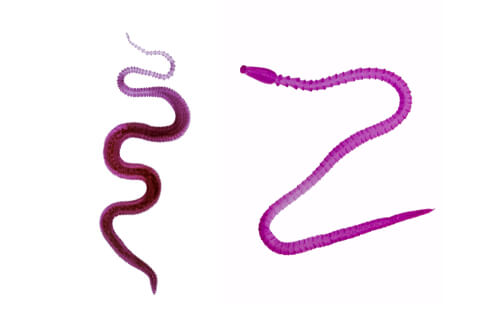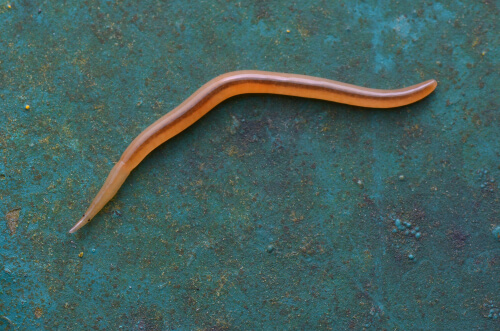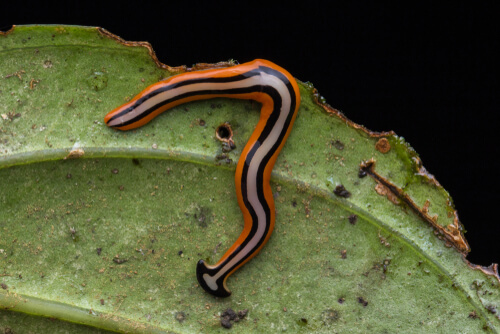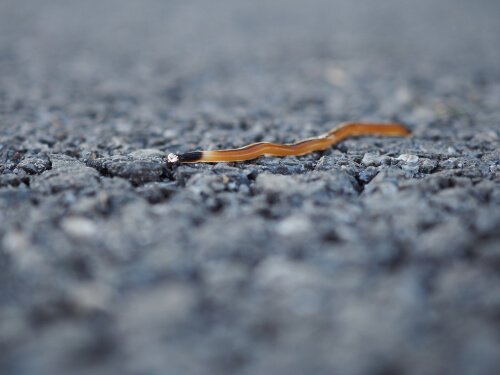
| Kingdom | Animalia |
| Phylum | Nemertea |
| Class | Multiple (roughly 900 species) |
| Niche | Benthic predator |
| Length | Most species between 0.1-2.040 in (0.1-100 cm) |
| Lifespan | Up to 24 months |
| Social Structure | Solitary |
| Conservation Status | Not endangered |
| Preferred Habitat | Benthic marine habitats |
| Main Food Items and Prey | Annelid worms, clams, crabs, fish |
| Predators | Fish, crabs, sea birds, other ribbon worm species |
The Basics
The ribbon worm, or nemerteans, is a group of segmented marine worms found throughout the world’s oceans. Ranging in size depending on the species, some ribbon worms grow very long. Indeed, the bootlace worm (Lineus longissimus), can grow longer than a blue whale, possibly making it the longest animal in the world.

Description
Nemerteans are a unique group of organisms that have a significant ecological role. The typical ribbon work is slim and long. The smallest species measure just a few millimeters in length and most are less than 8 inches long. However, some species are much larger, with many growing over a meter in length while the largest ever officially recorded was a specimen of Lineus longissimus. Although only a few millimeters wide, this specimen was measured to be more than 175 feet long. Longer than the blue whale, this may make L. longissimus the longest animal on earth.
The outside layer of nemertean’s bodies is made up of cilia that help them move, as well as glandular epithelium with rhabdites, specialized mucus-producing cells. The mucus produced by these rhabdites allows the cilia to move, providing mobility for the organism. Indeed, a trail of ‘slime’ can be observed behind most species. Ribbon worms have ventral mouths set back slightly from the front of the body. Its digestive system consists of a foregut, stomach, and intestine in the middle section of the body and its anus at the very tip of its tail.

The Proboscis Worm
All ribbon worms also have a proboscis – an infolding of the body wall – that can ‘unfold’ rapidly and is used to attack its prey. In the class Anopla, it exits from an orifice that is separate from the mouth and coils around its prey, immobilizing it with adhesive and toxic secretions. Some members of this class have a highly-branched proboscis, effectively forming a net that it throws over its prey before retracting it and drawing the prey into its mouth. In other classes, such as Enopla, the proboscis has a hard, calcareous (calcium-based) barb that it uses to stab its prey repeatedly, also injecting toxins and digestive enzymes in the process. The prey is then swallowed or partially digested first, depending on its size and the specific species’ feeding behaviors.
Distribution and Habitat
The majority of nemertean species are found in marine habitats, distributed throughout the world’s oceans. Some species, however, are aquatic, living in freshwater environments such as streams and ponds. Fewer still are entirely terrestrial, living their lives outside of the water.
Diet and Predators
Most ribbon worm species are carnivorous, feeding largely on annelids, clams, and various crustaceans such as crabs. Some species will also eat fish and many will scavenge on virtually anything they can find. The few terrestrial species of Argonemertes feed solely on insects and myriapods. Some species live inside the mantle cavity of various mollusks, feeding on small organisms filtered out by their host. In some cases, this relationship is parasitic, such as Carcinonmetes errans, which has reduced the egg production of its host the Dungeness crab, a commercially important species.

Due to their ability to fill small cracks, crevices, or even live inside other organisms, most nemerteans have few predators. In addition, most species secrete toxins that deter many would-be predators. Bottom-feeding fish and horseshoe crabs are known to feed on some species, while seabirds likely feed on those accessible in the intertidal zone.
Reproduction
Ribbon worms possess some unique and fascinating reproduction and regeneration strategies. Larger species often break into segments when disturbed, with each fragment normally growing into full individuals. In some species, this also occurs routinely and in the absence of disturbance or stimulation. Ribbon worms also reproduce sexually and are gonochoric – with distinct male and female members in most species. Fascinatingly, all freshwater species are hermaphroditic, in addition to some of the hundreds of marine species.
In most species, temporary gonads will form in a row down each side of their bodies. These are ejected through gonoducts, which are also formed temporarily, with fertilization typically occurring externally. In some cases, eggs and sperm are broadcasted into the water while in others they may be laid in a burrow or tube. Some species even build cocoon-like structures or gelatinous masses to protect them during development. The number of eggs produced by females of each species varies greatly and is not well understood in many species. Similarly, the lifespan of many species remains unknown. However, it is believed to be on the order of months, with Paranemertes peregrina having been observed to have a lifespan of approximately 18 months.
Fun Facts about the Ribbon Worm!
Besides being one of the longest animals in the world, ribbon worms are a fascinating group for many reasons. From their circulatory system lacking a central heart and their ability to respire through their skin, these lesser-known animals offer many opportunities to explore various biological concepts.
Heartless
Nemerteans have unique circulatory systems lacking a central heart. Instead, they have two or more lateral vessels that run along their body and are joined at the end to form a loop. These are filled with fluid analogous to blood that is circulated by the contraction of muscles in the vessels and the body wall. This circulatory system is considered a rudimentary version of more complex systems. In fact, ribbon worms are the simplest animals to possess a circulatory system of any form.

The Longest Animals
The largest species of ribbon worm is the bootlace worm, Lineus longissimus. This species is native to the North Sea where it can be found among rocks. Not only is it the largest species of ribbon worm, but it may be longer than the blue whale, making it the longest animal in the world.
Despite being only a few centimeters wide, this species has been regularly measured at lengths of over 100 feet and in some cases has been thought to grow to nearly 200 feet. However, due to the unique morphology that allows them to stretch and contract down to 10% of their maximum length, uncertainty remains around the accuracy of these measurements.
The Parasitic Worm
Not all ribbon worms are predatory. Instead, many live inside the mantle cavity of other species such as mollusks. In many cases, these are parasitic relationships. For example, a genus of ribbon worms known as Carcinonemertes is known to parasitize crabs such as the Dungeness crab. This ribbon worm lives on the crab, subsisting primarily on its eggs. This significantly reduces the reproductive capacity of the host individual which, in the case of this commercially fished species, has economic consequences for humans as well.
